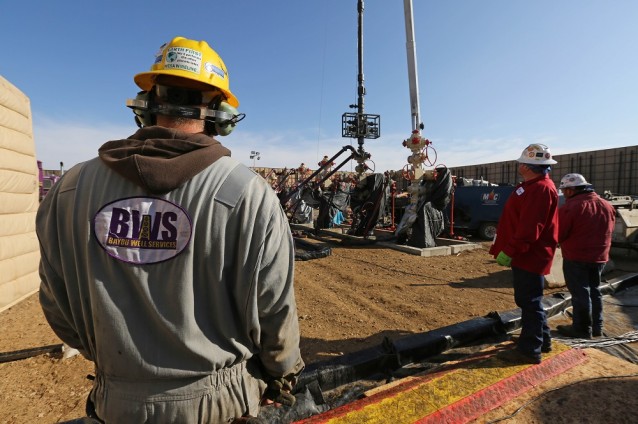"Why Are Four In Ten High-Risk Oil And Gas Wells Not Being Inspected?"

CREDIT: AP Photo/Brennan Linsley
Despite a new report showing that 40 percent of all high-risk oil and gas wells on public lands across the United States did not pass a safety inspection from 2009 to 2012, a powerful oil and gas industry trade group has doubled down on its opposition to the Obama Administration’s proposal to fix the problem.
E&E News reported last week that the Western Energy Alliance (WEA), a Denver-based trade association that represents oil and gas producers in the West, insists that oil and gas companies already pay enough fees and royalties to operate on federal lands and that taxpayers — not companies — should continue to cover the cost of safety inspections and environmental enforcement activities conducted by the Department of the Interior’s Bureau of Land Management (BLM).
“There’s no need for BLM to come back to industry to get more money,” WEA’s vice president, Kathleen Sgamma told E&E.
Recent reports suggest that the industry’s exemption from paying inspection fees is only one of several subsidies that benefit oil and gas companies drilling on federal lands. The federal royalty rate for oil and gas production, for example, is lower than that of many states, and half of what the State of Texas charges. It also costs less than a cup of coffee to rent an acre of federal land for a year to drill.
The extent to which the federal inspection program has fallen short was uncovered in a recent analysis by the Associated Press, which found that four in ten oil and gas wells drilled between 2009 and 2012 and flagged as high-risk by federal regulators went uninspected by the BLM.
BLM officials are aware of the deficiency in federal inspections for high risk areas, but note that the agency does not have enough staff or sufficient funding from Congress to keep pace with the rapid growth of oil and gas development on public lands in recent years. To address the problem, the Obama Administration has proposed that Congress allow the BLM to charge inspection fees of oil and gas companies operating on public lands, as is required of companies that drill offshore in federal waters.
In testimony before the House Appropriations Committee in April, BLM Director Neil Kornze stated that “the fees will help the BLM to improve production accountability, safety and environmental protection of oil and gas operations, and would parallel a fee system already in place for offshore oil and gas programs.”
As the federal government’s largest land management agency, BLM is responsible for 100,000 oil and gas wells located on public land, primarily in the West. The AP review of BLM records found that 3,468 of these wells are designated as “high-risk” or “high priority” due to their potential for pollution, or location near national forests and vulnerable watersheds, and 1,400 of these had not been inspected by the agency. In Colorado, Utah and Wyoming, almost half of the wells on federal and Indian lands went uninspected.
A May 2014 report by the Government Accountability Office (GAO) concluded that the federal government failed to inspect thousands of wells, and, as the AP reported, highlighted “substantial gaps in oversight by the agency that manages oil and gas development on federal and Indian lands.”
Even as oil and gas production on public lands continues to increase, Congressional appropriations for BLM’s oversight program has fallen since 2007. President Obama’s FY 2015 budget request “proposes to expand and strengthen onshore oil and gas inspections and oversight capability through fees comparable to those assessed for offshore inspections.” The Obama administration’s proposal would allow the agency to meet inspection responsibilities without increasing taxpayer burden by shifting responsibility to the oil and gas industry.
“We need to ensure that the oil industry is paying its fair share to drill on public lands,” Senate Environment and Public Works Committee member Edward Markey (D-MA) told the AP. Markey also asserted that the fines BLM charges for safety violations are not a deterrent for oil and gas companies to “put safety ahead of speed” on potentially dangerous wells.
Despite the need for safety inspections, the opposition of the oil and gas industry and its allies in Congress means the Obama administration faces an uphill battle with its proposal.
BLM has included its inspection fee reforms in fiscal budgets over the past five years, but the proposals have not yet been approved. The agency is working to make its case to Congress in the hopes that it will approve the fee this year.
Claire Moser is the Research and Advocacy Associate with the Public Lands Project at the Center for American Progress.






 FRONT
FRONT